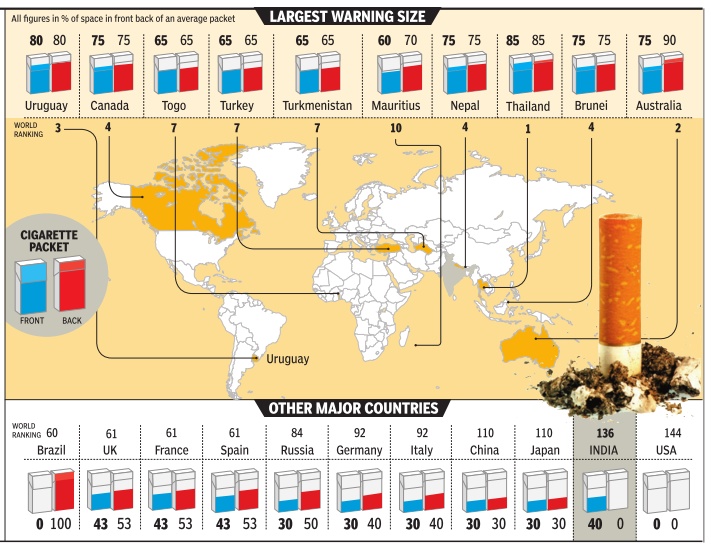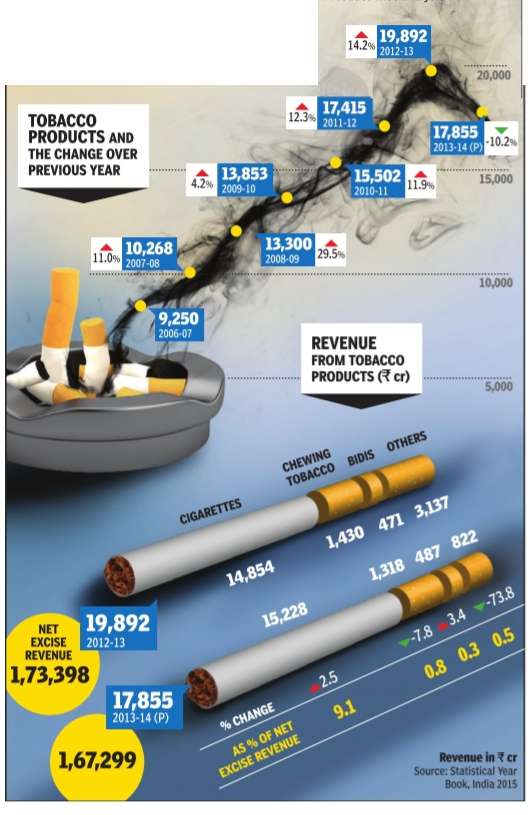Tobacco/ cigarette consumption: India
This is a collection of articles archived for the excellence of their content. |
Contents |
Tobacco :India 2012-14
The Times of India, Jan 27 2015
SMOKE SIGNALS
According to the WHO, tobacco is one of the world's biggest public health threats as it kills about six million people every year. Raising taxes on tobacco products has been found to be the most cost-effective method of reducing tobacco use. According to the recently released India Statistical Yearbook 2015, for the first time in eight years, excise revenue from tobacco products has witnessed a fall. Product-wise analysis suggests that excise revenue from chewing tobacco and other products has decreased between 2012-13 and 2013-14 while collections from cigarettes and biris have 19,892 14.2% 2012-13 increased. The increase, however, might be linked with the higher taxes imposed in recent years.
Tobacco Labelling
The Times of India, Oct 03 2015
Source: Tobacco Labelling Research Centre, International Status Report, Sep-2014; Research: Atul Thakur

According to the guidelines of the WHO Framework Convention on Tobacco Control, well designed pictorial warnings on cigarette packets are among the most cost-effective ways to increase awareness about the health effects of smoking.On an average, a pack-a-day smoker would look at it 20 times a day or over 7,000 times a year. According to the Tobacco Labelling Research Centre, an organisation developed with the support of the WHO Framework Convention Alliance and the International Union Against Tuberculosis And Lung Disease, pictorial warnings are mandatory in 77 countries. In 2001, Canada became the first country to implement such warnings. Thailand has the world's largest warning size.
2016: India, third largest pictoral representation
The Indian Express, November 11, 2016
After a long and bitter battle for 85 per cent pictorial warnings on tobacco packets, India has jumped from 136th position to third position on pictorial health warnings, according to a report released.
The Cigarette Package Health Warnings International Status Report by the Canadian Cancer Society was released at the seventh session of the Conference of the Parties (COP7) to the WHO Framework Convention on Tobacco Control (FCTC) being held at Greater Noida.
Tobacco use
2005-16: A decline
The Times of India, Mar 08 2016
Pushpa Narayan
Oral cancer among women on rapid decline: National Cancer Registry
For first time, tobacco use is down in country: Family health survey
The use of tobacco, the leading cause of preventable death, has for the first time begun to decline across country . Data from the first phase of National Family Health Survey released by the Union health ministry shows a dip in the use of all forms of tobacco, among men and women, in the past decade. Doctors are hailing the results as one of the biggest successes in public health.At least 11 of the 13 states in the report have reported a decline in the numbers between 2005-06 and 2015-16. In Sikkim, there is up to 20% dip in tobacco use. The only two states that showed incre ase in consumption were Manipur and Meghalaya.
Ten years ago, nearly half the men and, at least, a quarter of the women in rural areas consumed tobacco. Today , sustained campaign against the use of tobacco -including pictorial warnings on cigarette packets, ban on smoking in public places, complete ban on the sale of pan masala in several states, high taxes, warnings flashed on cinema and TV screens and from doctors -have helped bring down the numbers.
“Every bit of it has helped,“ said Chennai-based senior oncologist Dr V Shanta, who has been campaigning against tobacco manufacturers. “But our war is still not over. We still have a long way to go,“ she said.
The first sign of success is already visible in the national cancer registry . The incidence of oral cancer among women is on a rapid decline. The Madras Metro politan Tumour registry for instance has recorded a 33% drop in oral cancer among young women.
Until 1986, mouth cancer was the third amongst all forms of cancer affecting women with an incidence of 7.8 per 10,000. In 2012, it did not appear in the top five.“It's an indication that fewer younger women are opting for smokeless tobacco,“ said Dr R Swaminathan, head epidemiologist, Adyar Cancer Institute.
The tobacco industry too has also been reporting a consistent dip in production since 2011.
Studies by public health experts show similar trends.A study by Mumbai-based Dr P C Gupta, director, Healis Sekhsaria Institute for Public Health, in the journal BMJ Global Health showed the number of men smoking tobacco in India rising by more than one-third to 10.8 crores between 1998 and 2015.“The increase is only because the population has gone up. We saw no drastic increase in the prevalence of smoking across the country ,“ said Dr Gupta.
NGOs representing the anti-tobacco lobby say cases are being under-reported.“Sale of pan masala is still rampant. Pan masala comes in the form mouth fresheners. On several instances we have found tobacco branded as herbal, organic and spit free being sold to school students,“ said Cyril Alexander, convenor for TN People's Forum for Tobacco Control.
